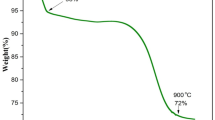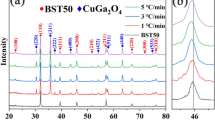Abstract
The electric polarization and dc conductivity as two main factors cause electric relaxation in dielectric ceramic, which are difficult to be distinguished from each other at high temperatures. In this work, it is found that the two key factors can be separated via conjoint analysis of various complex planes such as complex dielectric permittivity, the impedance, the electric modulus, and the ac conductivity planes. Taking ZnO ceramics as a typical example, the ac conductivity relaxations caused by the long range and short-range migration of charge carriers are discussed as a function of frequency at high temperatures (433–473 K). Under the applied ac electric field, the migration of charge carriers within the ZnO ceramic can be restricted by two high-resistance barriers from grain boundaries and intergranular phases. These barriers result in two dispersion processes in conductivity response, which exhibit two relaxation peaks with activation energies of 0.75 eV and 0.89 eV. It was proposed that, in high temperature region, the ac conductivity relaxations of ZnO ceramic are the result of carrier migration localized between grain boundaries, and carrier migration localized between intergranular phases.








Similar content being viewed by others
References
P. Lunkenheimer, S. Krohns, S. Riegg, S.G. Ebbinghaus, A. Reller, A. Loidl, Eur. Phys. J.-Spec. Top. 180, 61 (2010)
M.A. Alim, Active and Passive Elec. Comp. 19, 139 (1996)
Y. Huang, K. Wu, Z. Xing, C. Zhang, X. Hu, P. Guo, J. Zhang, J. Li, J. Appl. Phys. 125, 084103 (2019)
P. Cheng, S. Li, L. Zhang, J. Li, Appl. Phys. Lett. 93, 12902 (2008)
W. Li, R.W. Schwartza, Appl. Phys. Lett. 89, 242906 (2006)
X. Zhao, J. Li, H. Li, S. Li, J. Appl. Phys. 111, 124106 (2012)
B. Roling, A. Happe, K. Funke, M.D. Ingram, Phy. Rev. Lett. 78, 2160 (1997)
D.C. Sinclair, T.B. Adams, F.D. Morrison, A.R. West, Appl. Phys. Lett. 80, 2153 (2002)
T.T. Fang, C.P. Liu, Chem. Mater. 17, 5167 (2005)
X.T. Zhao, R.J. Liao, N.C. Liang, L.J. Yang, J. Li, J.Y. Li, J. Appl. Phys. 116, 014103 (2014)
P.B. Macedo, C.T. Moynihan, R. Bose, Phys. Chem. Glasses 13, 171 (1972)
K. Pathmanathan, J.R. Stevens, J. Appl. Phys. 68, 5128 (1990)
A. Ben Rhaiem, F. Hlel, K. Guidara, M. Gargouri (2008) J. Alloys Compd. 463: 440
G.M. Tsangaris, G.C. Psarras, N. Kouloumbi, J. Mater. Sci. 33, 2027 (1998)
F.Q. Tian, Y. Ohki, IEEE Trans. Dielectr. Electr. Insul. 21, 929 (2014)
C.C. Wang, L.W. Zhang, Appl. Phys. Lett. 90, 142905 (2007)
C.C. Homes, T. Vogt, S.M. Shapiro, S. Wakimoto, A.P. Ramirez, Science 293, 673 (2001)
J.Y. Li, X.T. Zhao, S.T. Li, M.A. Alim, J. Appl. Phys. 108, 104104 (2010)
T.T. Fang, H.K. Shiau, J. Am. Ceram. Soc. 87, 2072 (2004)
J.R. Macdonald, J. Phys. Chem. Solids 70, 546 (2009)
J.R. Macdonald, J. Non-cryst, Solids 197, 83 (1996)
P. Debye, Polar Molecules (Chemical Catalogue Company, New York, 1929)
S. Sanghi, A. Sheoran, A. Agarwal, S. Khasa, Phys. B 405, 4919 (2010)
J.C. Wurst, J.A. Nelson, J. Am. Ceram. Soc. 55, 109 (1972)
E. Olsson, G.L. Dunlop, J. Appl. Phys. 66, 3666 (1989)
M. Tao, A.I. Sui, O. Dorlanne, A. Loubiere, J. Appl. Phys. 61, 1562 (1987)
F. Greuter, G. Blatter, Semicond. Sci. Technol. 5, 111 (1990)
D.R. Clarke, J. Am. Ceram. Soc. 82, 485 (1999)
F. Kremer, A. Schönhals, Broadband Dielectric Spectroscopy (Springer-Verlag, Berlin Heidelberg GmbH, 2003)
A.K. Jonscher, Universal Relaxation Law (Chelsea Dielectrics Press, London, 1996)
M.M. Costa, G.F.M. Pires Jr., A.J. Terezo, M.P.F. Graca, A.S.B. Sombra, J. Appl. Phys. 110, 034107 (2011)
E. Barsoukov, J.R. Macdonald, Impedance Spectroscopy Theory, Experiment, and Applications, 2nd edn. (Wiley, New York, 2005)
Y.W. Hong, J.H. Kim, Ceram. Int. 30, 1307 (2004)
M. Andres-Verges, A.R. West, J. Electroceram. 1, 125 (1997)
K. Eda, I.E.E.E. Electr, Insul. M. 5, 28 (1989)
C. Leach, K.D. Vernon-Parry, N.K. Ali, J. Elctroceram. 25, 188 (2010)
D.C. Sinclair, A.R. West, J. Appl. Phys. 66, 3850 (1989)
Acknowledgements
This research was financially supported by Fund of the National Natural Science Foundation of China (No. 51877016), the Natural Science Foundation of Chongqing (No. cstc2019jcyjxfkxX0008), and the Fok Ying-Tong Education Foundation, China (No. 171050).
Author information
Authors and Affiliations
Corresponding author
Additional information
Publisher's Note
Springer Nature remains neutral with regard to jurisdictional claims in published maps and institutional affiliations.
Rights and permissions
About this article
Cite this article
Zhao, X., Li, Y., Ren, L. et al. High temperature ac conductivity relaxations in dielectric ceramics: grain boundary/intergranular phase effects. J Mater Sci: Mater Electron 31, 16468–16478 (2020). https://doi.org/10.1007/s10854-020-04201-0
Received:
Accepted:
Published:
Issue Date:
DOI: https://doi.org/10.1007/s10854-020-04201-0




